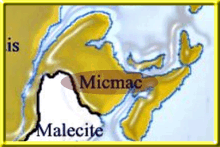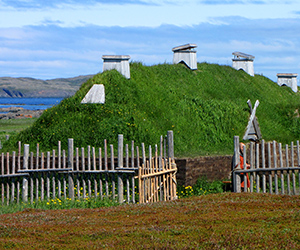CANADA HISTORY
Beothuk

The Beothuk people were an Indigenous group that once lived on the island of Newfoundland, in what is now Canada. Their name, "Beothuk", translates to "human being," but it was Europeans who coined the term "red man" to describe them, a label that later became widely used to refer to Indigenous peoples across North America. The Beothuk were known to paint themselves with bright red ochre, which contributed to this European description.
 Culture and Social Structure
Culture and Social Structure
The Beothuk people had a semi-nomadic lifestyle, relying heavily on hunting, fishing, and gathering to sustain themselves. Their primary food sources included caribou, seals, salmon, and shellfish, as well as various wild plants and berries. They were skilled in creating tools from stone, bone, and wood, which they used in hunting and food preparation. The Beothuk’s diet was largely shaped by the seasonal availability of resources. During the summer months, they lived along the coast, taking advantage of the rich marine life, while during the winter, they moved inland to hunt caribou and other game.
The Beothuk crafted canoes from birch bark and used them to navigate Newfoundland’s rivers and lakes. Their canoes were lightweight, which made them well-suited for the frequent portages necessary to move between hunting grounds. The Beothuk also had a tradition of basket weaving, which was a significant part of their culture and craftsmanship.
Their social structure was organized into small, autonomous bands of extended families. Each band likely had a leader, often a respected elder or hunter, who would make decisions on behalf of the group. There is little evidence to suggest a formal political structure, as their semi-nomadic way of life did not necessitate a highly stratified society. However, gender roles were distinct: men primarily hunted and fished, while women gathered food and were responsible for tasks such as processing game and preparing meals.
Territory and Geographic Area
The Beothuk traditionally lived throughout Newfoundland, but after European contact in the 16th century, they were gradually pushed inland and into more remote areas on the western part of the island. Their displacement was a direct result of European fishing operations and the establishment of settlements along the coast, which disrupted the Beothuk’s traditional access to marine resources. The arrival of Europeans forced the Beothuk to retreat from the rich coastal areas, leading to increased hardship as they were confined to less resource-abundant inland territories.
The Beothuk people were one of the few Indigenous groups that did not engage in regular trade or cooperation with Europeans, choosing instead to maintain their distance and avoid contact. This isolation contributed to their vulnerability as European settlement increased.
Spiritual Beliefs
The religious beliefs of the Beothuk revolved around a deep connection with the natural world. The sun held special significance in their spiritual system, and it is believed they worshipped the sun and moon as central deities. They also had a concept of Manitou, a powerful supernatural being that played a central role in their worldview, influencing everything from daily life to hunting success.
Ceremonial practices included the use of red ochre, which they painted on their bodies, tools, and belongings. This practice may have had spiritual or protective significance, as red ochre was believed to be imbued with life-giving properties. The Beothuk also constructed burial mounds for their dead, covering the bodies with red ochre, indicating the importance of this pigment in their spiritual and cultural identity.
Warfare and Relations with Other Groups
The Beothuk were known to have had hostile relations with several Indigenous groups, including the Mi'kmaq and possibly the Inuit. Conflicts may have stemmed from competition over resources, especially after European settlers began encroaching on their traditional hunting and fishing grounds. The arrival of the Mi'kmaq, who were sometimes armed by the French, put further pressure on the Beothuk as they were increasingly driven away from the coastline and faced competition for inland resources.
The Beothuk likely avoided frequent warfare with Europeans by maintaining a policy of isolation. However, there were occasional violent encounters, particularly when the Beothuk attempted to take back European tools and supplies left behind at fishing stations. Europeans, in turn, sometimes retaliated violently against the Beothuk, further exacerbating the tension between the two groups.
Contact with Europeans and Decline
The first recorded European contact with the Beothuk occurred in the late 15th century, but it was not until the early 17th century that sustained contact began. European fishermen and settlers arrived in Newfoundland, disrupting the Beothuk’s way of life by encroaching on their coastal hunting and fishing areas. The Beothuk, in response, retreated inland, but this strategy ultimately led to food shortages and increased hardship.
In addition to displacement, the Beothuk were also severely impacted by European diseases such as smallpox and tuberculosis, to which they had no immunity. The combination of disease, loss of territory, and conflict with both Europeans and other Indigenous groups contributed to the rapid decline of their population.
By the late 18th century, the Beothuk population had dwindled significantly, and violence between the Beothuk and European settlers escalated as resources became scarcer. European settlers also began capturing Beothuk individuals and forcing them into slavery or other forms of exploitation. These factors combined to create a dire situation for the Beothuk, who by the early 19th century were on the brink of extinction.
The Last Beothuk and Legacy
The last known member of the Beothuk people was Shanawdithit, who died in 1829. Shanawdithit was captured by European settlers and became a source of valuable information about the Beothuk way of life. She provided drawings and descriptions of Beothuk culture, helping to preserve some knowledge of their customs, beliefs, and traditions. Her death marked the end of the Beothuk as a distinct cultural group, but her legacy and the memory of her people live on.
Although the Beothuk became extinct as a distinct people, their story remains an important part of Canadian history. Their experience is a stark reminder of the devastating effects of colonialism, displacement, and disease on Indigenous populations. Today, their history is honored and remembered, and efforts are made to ensure that the Beothuk’s place in the history of Newfoundland and North America is not forgotten.
Timeline of Beothuk History
Pre-Contact Era: The Beothuk lived throughout Newfoundland, subsisting through hunting, fishing, and gathering. They maintained relative isolation from other Indigenous groups, though there may have been some interaction with neighboring peoples.
Late 15th Century: European fishermen and explorers make first contact with the Beothuk. This contact was limited but would later lead to more sustained interactions as Europeans began settling on the island.
17th Century: As more Europeans arrived, the Beothuk were forced to retreat inland. Encroachment on their coastal territories led to increased conflict and resource scarcity.
18th Century: The Beothuk population rapidly declines due to displacement, European diseases, and conflict with settlers and other Indigenous groups.
1829: Shanawdithit, the last known Beothuk, dies in Newfoundland, marking the end of the Beothuk people as a distinct group.
The story of the Beothuk is a tragic chapter in the history of Indigenous peoples in North America. Their experiences highlight the impact of European colonization on Indigenous communities, and their memory continues to shape discussions about Indigenous rights, historical preservation, and reconciliation in Canada.
Cite Article : www.canadahistory.com/sections/documents




